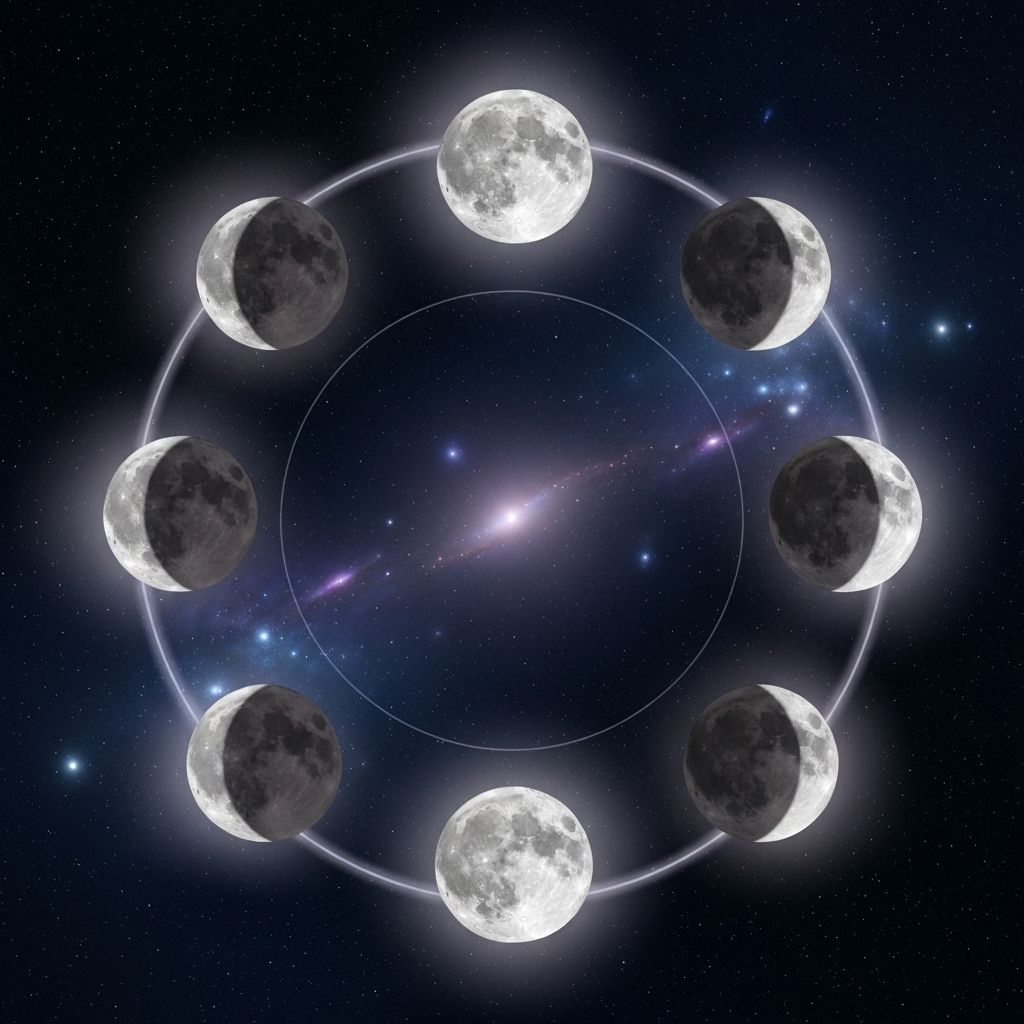Moon Phases: 8 Key Stages And Lunar Mysteries
Explore the phases of the moon, why they change, and how lunar cycles shape our night sky throughout the year.

Image: HearthJunction Design Team
Moon Phases: Understanding the Lunar Cycle and Its Mysteries
The moon has fascinated humanity since the dawn of time. Its ever-changing appearance in our night sky serves as a calendar, guiding ancient civilizations and modern astronomers alike. But what exactly are the phases of the moon, and what causes them? This comprehensive guide unveils the mysteries behind lunar phases, explores the entire lunar cycle, and explains why the moon appears different each night.
What Are Moon Phases?
Moon phases refer to the different shapes of the illuminated portion of the moon as seen from Earth. As the moon orbits our planet, varying amounts of sunlight reflect off its surface, creating eight distinct phases over about 29.5 days—the duration of one lunar month. These phases are easy to observe and have inspired myths, legends, and scientific inquiry for millennia.
Why Does the Moon Change Shape?
Contrary to common belief, the moon does not create its own light. What we see as ‘moonlight’ is actually sunlight reflected from the moon’s surface. The sun always illuminates half of the moon, but from Earth, we see different portions of this sunlit half as the moon moves along its orbit. This movement results in the cycle of lunar phases.
- The Sun: The only source of light in our solar system. Its rays shine on Earth and the moon, illuminating one side of each.
- The Moon: Reflects sunlight. The side facing the sun is lit up, while the other half is in darkness.
- Earth’s Perspective: As the moon revolves around Earth, the angle between the sun, moon, and Earth changes, revealing varying portions of the moon’s illuminated half.
This interplay between sunlight and the moon’s orbit explains why we sometimes see a thin crescent and, other times, a glowing full moon.
The Eight Phases of the Moon
The lunar cycle consists of eight main phases, each marking a different stage as the moon orbits Earth:
| Phase Name | Description |
|---|---|
| New Moon | The moon is positioned between Earth and the sun, so the side facing us is dark and invisible. |
| Waxing Crescent | A thin crescent appears as a sliver of sunlight begins to illuminate the moon’s right side. |
| First Quarter | Half the moon’s disk is illuminated on the right. It rises at noon and sets at midnight. |
| Waxing Gibbous | More than half is illuminated, but not yet full. The light grows toward the full moon. |
| Full Moon | The entire face is illuminated. The moon rises at sunset and sets at sunrise, appearing fully round and bright. |
| Waning Gibbous | After a full moon, the light starts shrinking from the right, leaving more than half still visible. |
| Third Quarter (Last Quarter) | Half of the moon is illuminated, now on the left side. It rises at midnight and sets at noon. |
| Waning Crescent | A shrinking crescent remains on the left before the moon returns to the new moon phase. |
Moon Phase Sequence
- New Moon
- Waxing Crescent
- First Quarter
- Waxing Gibbous
- Full Moon
- Waning Gibbous
- Third Quarter
- Waning Crescent
This sequence repeats itself each lunar month.
What’s the Moon Phase Tonight?
The specific moon phase for any given night can be found using online lunar calendars and widgets. These tools show the current phase and upcoming changes, providing enthusiasts and astronomers a quick way to track the moon’s appearance.
- Moon phases shift nightly, evolving from new to crescent to full, and then back to new.
- Major astronomy organizations, such as NASA, offer detailed lunar calendars covering the entire year.
- Apps and dedicated widgets display the moon’s current phase in real time.
How Do Moon Phases Affect the Night Sky?
The phases of the moon influence not only its appearance, but also events such as eclipses, tide cycles, and visibility of celestial objects.
Moonrise and Moonset
- Full Moon: Rises at sunset and sets at sunrise, making it visible all night.
- New Moon: Rises and sets with the sun, making it mostly invisible to observers on Earth.
- Quarter Moons: Rise and set at different times, providing visibility in the early evening or morning.
Tidal Effects
- The moon’s gravity generates tidal bulges on Earth’s oceans.
- Highest high tides, known as spring tides, occur during the full and new moon phases.
- Lowest low tides, called neap tides, occur during the first and third quarters.
Lunar and Solar Eclipses
- Lunar Eclipses: Occur during full moons when Earth’s shadow covers the moon.
- Solar Eclipses: Happen at new moons, when the moon passes between the sun and Earth, casting a shadow on Earth’s surface.
Frequently Asked Questions (FAQs) About Moon Phases
Q: What causes the different phases of the moon?
A: The moon’s phases are caused by its orbit around Earth, which exposes different portions of the sunlit side of the moon to viewers on our planet.
Q: How long does it take to complete a lunar cycle?
A: One complete lunar cycle (from new moon to new moon) takes about 29.5 days.
Q: Is there always a full moon every month?
A: Almost every month has a full moon, but occasionally, a single calendar month can have two full moons (the second is called a “blue moon”).
Q: Does the moon make its own light?
A: No, the moon only reflects sunlight. The surface of the moon is illuminated by the sun on one side, which is what we see as moonlight.
Q: How do astronomers predict moon phases?
A: The regularity of the moon’s orbit allows astronomers to calculate and publish lunar calendars with great accuracy.
Q: Why does the same side of the moon always face Earth?
A: The moon is tidally locked with Earth, rotating at the same rate that it orbits, so we always see the same face.
Observing the Moon: Tips for Stargazers
Whether you are a casual skywatcher or a seasoned astronomer, observing the moon can be a rewarding experience. Here are some tips for the best lunar viewing:
- Use binoculars or a small telescope to see lunar features like craters and maria.
- The best time to observe surface detail is during the crescent and quarter phases, when shadows are most pronounced.
- Mark key lunar events on a calendar, such as full moons, eclipses, or supermoons, for skywatching opportunities.
- Track the moon’s location and phase using online lunar calendars or astronomy apps.
Notable Moon Phases and Events in 2025
| Moon Phase | Date (2025) |
|---|---|
| New Moon | July 5 |
| First Quarter | July 13 |
| Full Moon | July 21 |
| Third/Last Quarter | July 27 |
These dates offer a guide to some of the most visible phases in the 2025 lunar cycle.
The Scientific and Cultural Importance of Moon Phases
The lunar cycle has profound implications beyond science. Many cultures historically based their calendars on the moon. Its phases marked religious festivals, guided agricultural activities, and influenced folklore worldwide.
- Ancient timekeeping was often lunar-based, using the consistent cycle of phases as a monthly marker.
- Festivals in many cultures were scheduled according to full or new moons.
- The moon’s phases have inspired countless myths, poems, and legends across the ages.
Conclusion
The moon’s phases represent a continuous celestial dance between the sun, Earth, and our lone natural satellite. Observing the transitions from new to full moon and back connects us to the rhythms of the cosmos, just as it did for our ancestors. Understanding these phases not only enriches our appreciation for the night sky, but also deepens our knowledge of Earth’s place in the universe.
Frequently Asked Questions (Expanded)
Q: Can the phases of the moon affect human behavior?
A: While many myths suggest the moon influences moods or events, scientific studies have found little consistent evidence linking lunar phases to human behavior.
Q: Are there any months without a full moon?
A: Yes, February sometimes lacks a full moon due to the lunar cycle’s length compared to the calendar month.
Q: What is a supermoon?
A: A supermoon occurs when a full moon coincides with the moon’s closest approach to Earth, making it appear larger and brighter.
Q: What equipment is needed to photograph moon phases?
A: A tripod-mounted camera with a zoom lens or a telescope with camera adapter yields detailed images. Adjust exposure for best results.
Q: Why are some full moons called “harvest moon” or “hunter’s moon”?
A: Traditional names for full moons often reflect seasonal activities or folklore linked to the time of year.
References
Read full bio of Srija Burman











